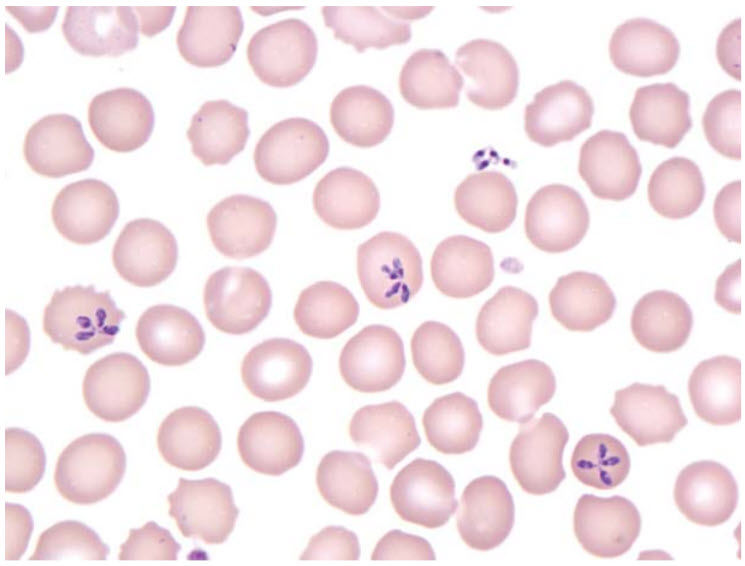Question 10#
A 48-year-old man presents to the Emergency Department with fevers, headache, fatigue, and yellowing of his skin and eyes. The constitutional symptoms began 3 days ago, and he thought it was the flu. This morning, his girlfriend noticed that his eyes appeared yellow. He has a history of hypertension and Graves disease, which are both stable. The patient lives in rural New York and is a nature photographer. He has no pets and does not smoke. Initial laboratory values are significant for a hemoglobin of 9.6 mg/dL, a serum leukocyte count of 14,500/mm3 , and a serum lactate dehydrogenase of 210 U/L. His peripheral blood smear is shown in Figure below.

Which of the following is the most likely diagnosis?
A. Plasmodium falciparumB. Strongyloides stercoralis
C. Clonorchis sinensis
D. Echinococcus granulosus
E. Babesia microti
Correct Answer is E
Comment:
Babesia microti. Babesiosis is caused by the parasite Babesia microti, which is carried by Ixodes ticks. Patients often present with nonspecific flu-like symptoms and a hemolytic anemia, which is indicated by this patient’s low hemoglobin and high serum lactate dehydrogenase. The peripheral blood smear shows the parasites within RBCs, confirming the diagnosis. If merozoites are present within RBCs, a “Maltese cross” pattern is seen. Treatment is with azithromycin and atovaquone in mild cases, or quinine and clindamycin in severe cases.
(A) Plasmodium falciparum causes malaria and should be considered since it also infects RBCs and produces fever and hemolytic anemia. (B) Strongyloides is a nematode and one of the most common parasitic infections worldwide. Infection occurs within the small intestine and can cause intestinal obstruction requiring surgery. (C) Clonorchis sinensis is a liver fluke that resides in the biliary tract and can cause obstructive jaundice; however, it does not produce intraerythrocytic inclusions. (D) Echinococcus granulosus is a tapeworm that typically causes disease of the lung and liver. It can cause liver cysts, which should not be biopsied (if possible) given the risk of a subsequent anaphylactic reaction. Ehrlichiosis is also a tick-borne infection but is caused by gram-negative bacteria and does not cause RBC inclusions. Borrelia burgdorferi is a spirochete that causes Lyme disease, which manifests acutely with a flu-like illness and erythema migrans. Rickettsia rickettsii causes Rocky Mountain spotted fever, but this patient does not have a rash.